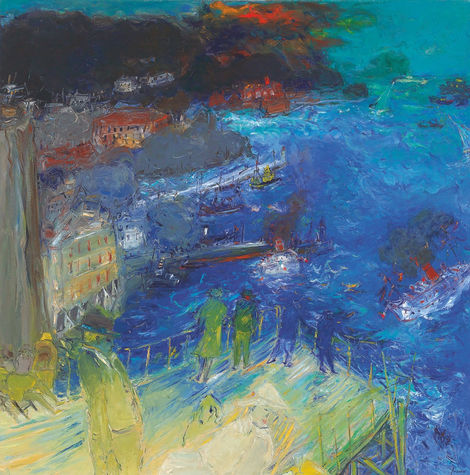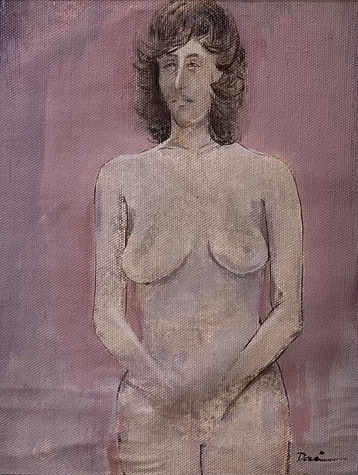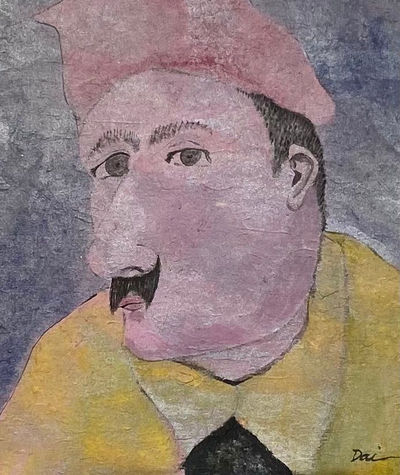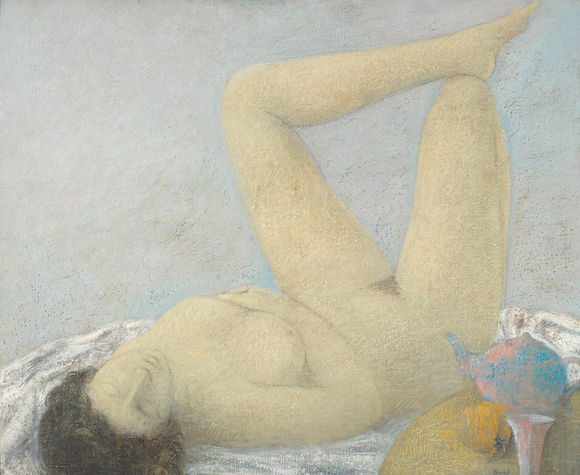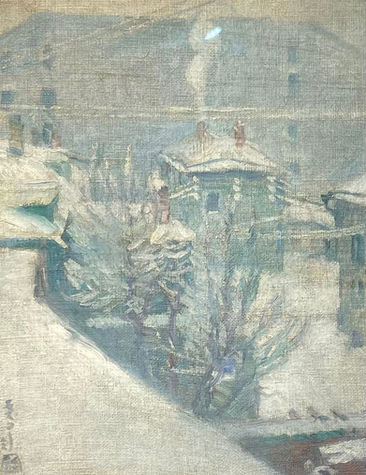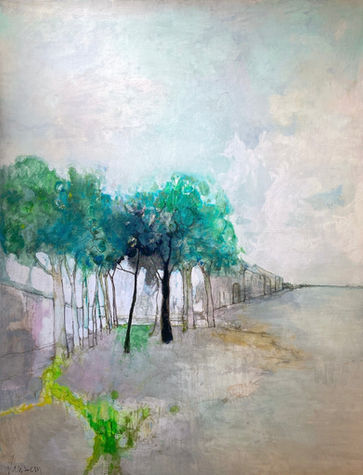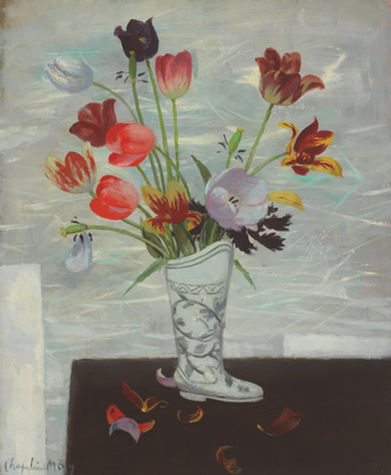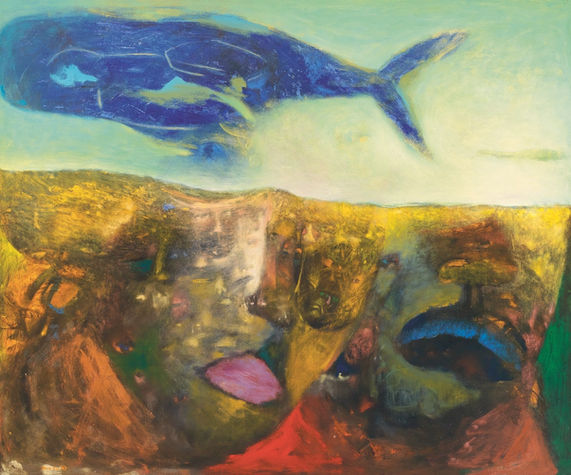Kinichiro Ishikawa (1871-1945)
Born in Shizuoka, Japan, he started studying painting in middle school. At the age of 28, he decided to go to England to learn traditional British watercolor painting methods from him, and since then he has established his own style. After returning to Japan, he went to mainland China and served as a military translator during the Russo-Japanese War. During this period, he traveled to various parts of Northeast China, sketching and painting. After the Russo-Japanese War, he was sent to Taiwan as an interpreter at the Governor-General's Office and concurrently as an art instructor at the Mandarin School. Later, he taught in Taiwan many times, and served as a teacher in the drawing department of Taipei No. 1 Normal School and Taipei Normal School. He was the enlightener of modern Western art in Taiwan and the pioneer of art education in Taiwanese schools, allowing Taiwanese students to be exposed to Western art education. , was deeply influential in Taiwanese painting circles in the 1920s, and his students included Li Shiqiao, Ni Jianghuai, Lan Yinding, Li Zefan and others.
Dai Biyin (1946-)
Artist Dai Biyin, who has lived in Spain for a long time, was Yang Sanlang's disciple when he was a student. He is one of the few creators in Taiwan who ranks among the masters of the European art world. His works were influenced by the ideological trends of the 1970s, starting from research and thinking on the nature of matter. He has studied oriental paper throughout his life and was hired as a consultant to the Barcelona Paper Museum. Graduated from the Fine Arts Department of the National Academy of Fine Arts, he went to Spain in 1975, where he continued to explore and think about expressive materials and visual languages that were more appropriate and could better convey his inner world. His creations are rooted in local culture and life experience, with free and unrestricted expression.
Aliex Fu (1961-)
Born in Taiwan, graduated from the Fine Arts Department of the Chinese Culture University in Taipei in 1985. In 1987, Aliex Fu lived in France as an artist. Fu Qingfeng's deformed world is a transformation between Surrealism and Cubism. Through inner experience, he creates the life energy of his works one by one, and his background from Taiwan. This prompted him to have a deeper observation of Chinese and Western art. He combined the concept of Eastern religious reincarnation into Western oil paintings to deduce his unique way of discussing the value of life. Each work records every detail of his life and then presents it. The most faithful aspect of life experience, the wandering and illusory characters in the painting move from darkness to brightness, and they also record the growth of the artist without any hidden effort.
Lin Hung-Wen (1961-)
Lin Hung-Wen's works are based on "Zen" ideas - shamanistic paintings, sculptures and installations, revealing the intensity of an artist. They are both precise and accurate, mysterious and unique. Regardless of the medium, there are always invisible and obscure connections. The works are cleverly integrated, and the sculptures and paintings have their own vitality and energy. The ancient Chinese called it "Qi", and this "Qi" exists in "natural" and "man-made" forms. Lin Hongwen's works reveal a hidden structure, with underlying currents flowing between the component parts. Whether they are two or three dimensions, graphic or abstract, is less important than their ability to reveal the energy within.
Jean FUSARO (1925-)
Born in Marseille, France in 1925, Jean Fusaro studied in the École nationale supérieure des Beaux-Arts de Lyon (National School of Fine Arts in Lyon). His exceptional gift in painting naturally sent him on the road toward becoming an artist, and he won various awards, including the Biennale de Menton (Menton Biennale), Prix Fénéon (Feneon Prize) and the Prix de la Jeune Peinture (Young Painters’ Prize). He has been invited to the exhibitions in Paris, Tokyo, New York and various cities since 1950. Fusaro, in his early years, was regarded as an important member of the “Lyon School,” along with A. Cottavoz and J. Truphemus. Later, Fusaro and Cottavoz became representative painters of the Parisian Neo-Figurative School. They were influenced by Post-Impressionism and the expression of light in the works of P. Bonnard, a representative artist of Les Nabis. Fusaro, even more than the others, creates directly with white to represent the rhythm between light and shadow. Fusaro inherits the simplified and deformed decorative style of the French avant-garde Les Nabis school, which stressed the expression of poetic reality in painting. Fusaro’s works are well-acclaimed, collected in the City of Paris Museum of Fine Arts, the Yamagata Museum, the Nagoya City Art Museum, and by various private collectors.
Jean JANSEM (1920-2013)
Jean JANSEM was born in Bursa, Turkey in 1920. He is a French painter of Armenian origin. The gentle use of colors gives the painting a romantic and quiet spatial level, and the color layout envelops the painting in a quiet atmosphere. The artist's intention in portraiture is by no means limited to depicting the appearance of a certain protagonist. shape and appearance, and attempts to regard painting as an extension of existence through the depiction itself. Jensen's landscape works always have an atmosphere of tranquility and tranquility. The painter uses his heart and eyes to express the freehand brushwork in realism and realize the thoughts, soothing the turbulent hearts of modern people
Gabriel DAUCHOT (1927-2005)
Gabriel Dauchot was born in 1927 in Livry-Gargan near Paris. Encouraged by an architect father, he began painting at the age of 14 and enrolled at the Ecole des Beaux Arts de Paris in 1942. In 1944, he was admitted to Salon d'Automne, the following year, his first solo show took place at the Galerie Granoff. Another one-man exhibition was held in 1947 at the Galerie Cardo. In 1951, Dauchot received the Prix de la Société des collectionneurs et amateurs d’art.
Julian TAYLOR (1954-)
Taylor, a contemporary British figurative painter, studied at the British Academy of Art for two years before deciding to create on his own. Lived in France since 1975. Taylor's favorite subjects include lighthouses, docks, harbors, vintage rigging or sailing ships. Taylor's precise painting technique brings an air of sophistication to his work. He uses his own artistic language to re-express a lyrical and poetic world to enhance the viewer's feelings in real life.
Alex BERDAL (1945-)
Alex Berdal was born on June 9, 1945, at Perpignan, France. He is one of the members of the Autumn Salon and the Salon des Artistes Français. Berdal is an award-winning painter and sculptor who used to study in the National School of Fine Arts in Paris. The many prizes he won includes the Prix de Rome in 1968, the International Grand Prize from Prince Rainier III of Monaco in 1969, the Gold Medal of the Salon des Artistes Français in 1978, the Taylor Prize of the Autumn Salon in 1979. Berdal had been exhibited in French Senate Orangerie in 1974, as well as in the United Kingdom, Germany, Switzerland, the Netherlands, Russia, and Japan. His art had been included in the collection of Tehran Museum of Modern Art in Iran, Paris City Museum, and Palace of Fontainebleau.
Bernard CHAROY (1931-)
Bernard Charoy was born on May 26th, 1931 in Nant le Grand, Lorraine region, East of France. Charoy is famous for his portraits of women. The delicate enchanting sentiment features in his poetic landscape works as well. Charoy began to work at the Montmartre Studio, where he studied painting and lithography from the local artists, painters and designers, in 1955. In the 1960s, Charoy had accepted consignments from news and magazine agencies to create attractive artwork especially for the press media. Since 1970s, Charoy’s work have been exhibited around the world, including the United States, Germany, Japan, Taiwan, Singapore, France and Belgium.
Bernardino TOPPI (1936-)
Toppi was born in a rome artist family. His work was first exhibited in the Paris Young Painter Salon in 1960. Toppi founds his artistic origin from high antiquity heritage. He thinks that the fresco is the most perfect form of monumental painting. In 2011, he held solo exhibition in the Grand Palais in Paris. Toppi has been awarded the Medal of Gold of Salon des Artistes Français in 1986, Taylor Prize of Autumn Salon in 2010, and First Jean Anouilh Prize of S.N.B.A. in 2010. His works are collected by Musée d'art moderne de la Ville de Paris, Petit Palais of Geneva, Besançon Museum of Fine Arts and Archeology and more.
CHANG Keng-hau (1980-2018)
Both born in 1980 in Taipei, Chang Keng-hau and Chang Geng-hwa are twin brother artists. Chang Keng-hau graduated from sculpture department, National Taiwan University of Arts in 2003, and received the master's degree from Graduate School of Arts and Technology, Taipei National University of the Arts in 2007. Chang Geng-hwa graduated from Sculpture Department, National Taiwan University of Arts in 2002. Keng-hau's works are mainly graphic design and interactive video, and Geng-hwa specializes in mechanical dynamics and the shape of works. Their works join various exhibitions including "Flying Yoyo" Exhibition (Tamsui Center of Arts & Culture, Taipei county, 2003), "Fiction Love - Ultra New Vision in Contemporary Art" (MoCA Taipei, 2004) and "Screw it–Chang Keng-hau Chang Geng-hwa Solo Exhibition" (NHCUE Arts Space, Hsinchu County, Taiwan, 2006) and "Animamix Biennial: From Modernity to Eternity" (MoCA Shanghai, 2007) etc..
.png)



